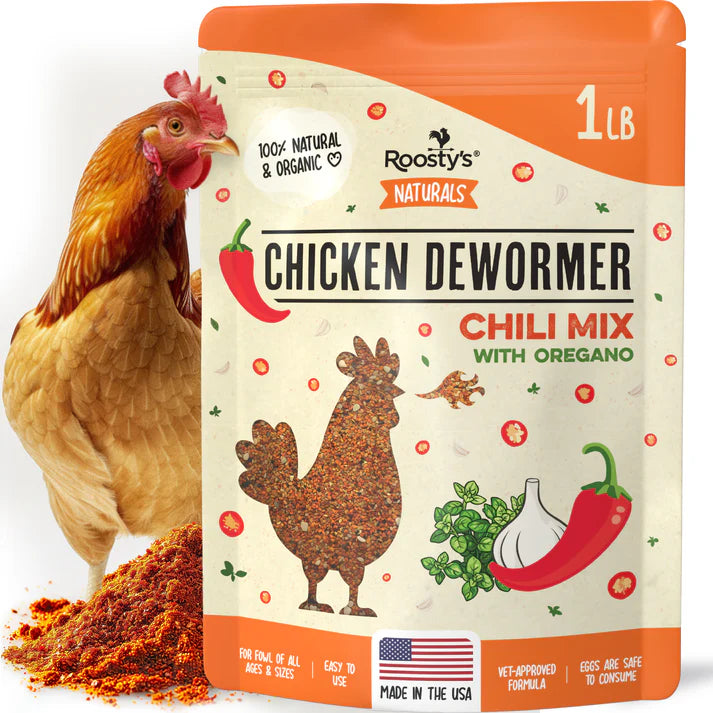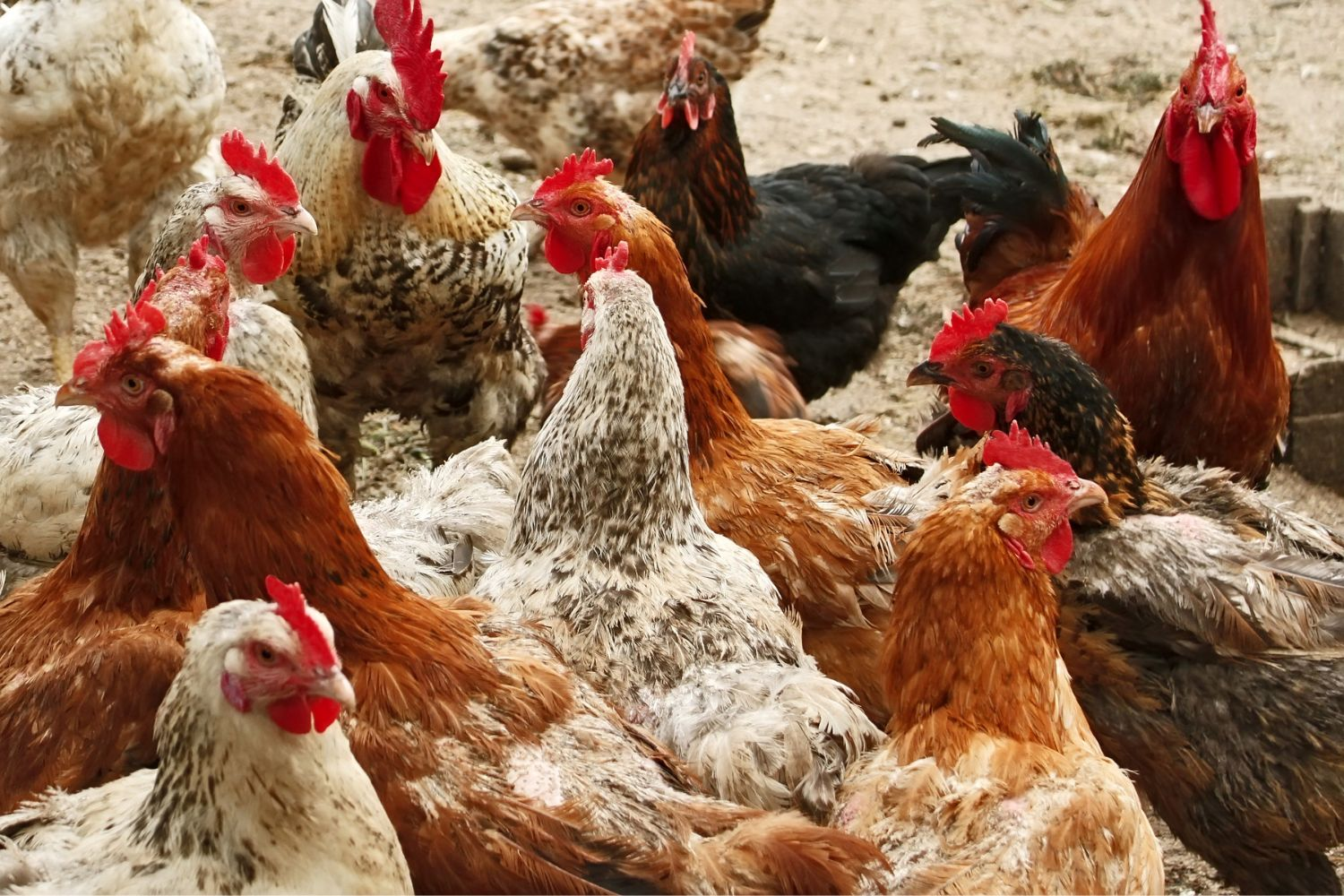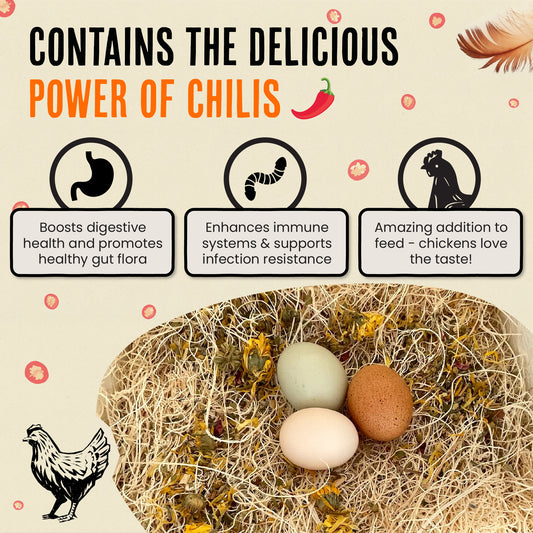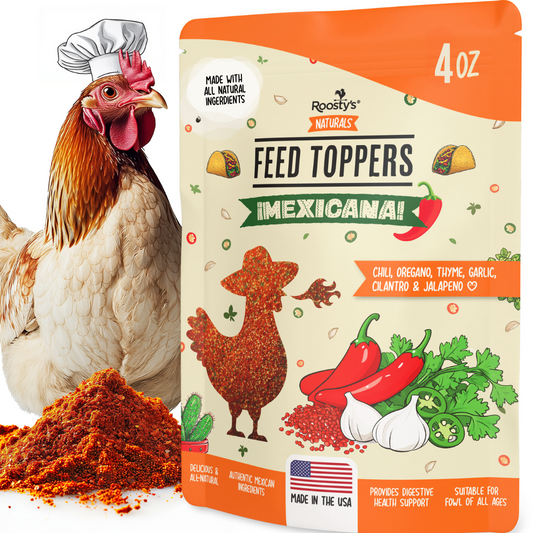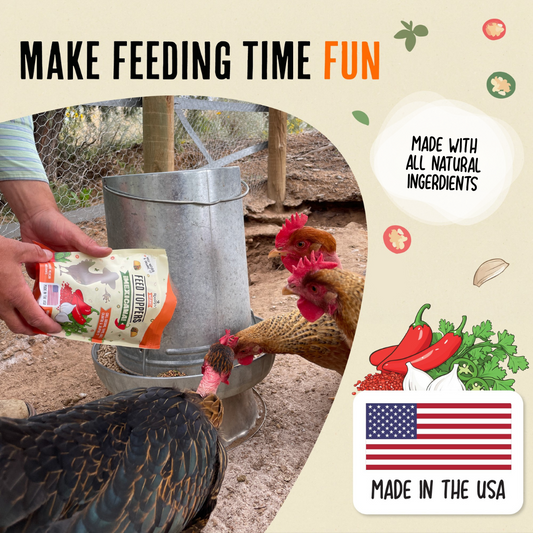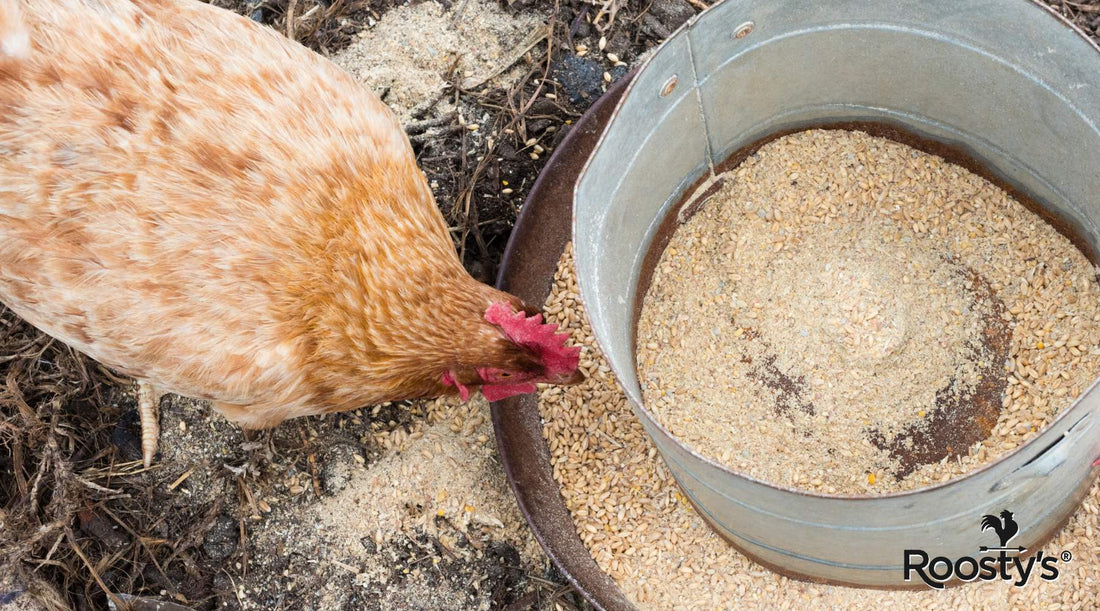
The Best Chicken Feeder for Efficient Feeding

As someone constantly seeking fresh products, keeping chickens has been an obvious decision. Yet, along with the delivery of fresh and delicious eggs every day comes the mess.
Chickens can be very messy eaters! When I first started with chicken farming, I needed to clear the backyard many times a day after feeding them. So, if this sounds like the kind of problem you are facing too, you’re in luck!
I’ve delved into the world of chicken feeding systems to discover the best chicken feeders for backyard chickens.
I have spent a long time studying and experimenting with different types of chicken feeders so you don’t have to.
So, whether you are looking for the best automatic chicken feeder for 20 chickens or for the best hanging chicken feeder for your small flock, this handy guide can hopefully push you in the right direction.
Believe me, I have left no stone unturned in my quest for the most efficient solutions.
Now, imagine a feeding setup that not only saves you time and money, but also keeps you flock happy and healthy? Because, the one thing we all hate about feeding messy eaters, is the waste.
Keeping chickens is also an investment. So, of course, you don’t want messy eating to cost you money and time.
Let me guide you through the different types of feeders, and help you choose the right setup for your coop, your flock, and your environment.
Whether you’re a seasoned chicken keeper trying to upgrade an existing feeding system or you’re a beginner taking your first steps into the world of poultry care, your journey to optimal chicken feeding starts here and now!
--------
Best Chicken Feeder to Prevent Waste
Chicken have the uncanny ability to transform their feeding area into a scattered mess in the blink of an eye. I’ve witnessed firsthand the ways chickens can waste food and the consequences for your backyard chicken farm.
How Chickens Create Waste
Chickens naturally engage in scratching and flicking behaviors. So, if their feeder gives them full access to scratch, peck, and flick, you can bet that a substantial amount of feed will end up on the ground.
The problem is that you can’t always collect the feed off the ground and put it back into the feeder. You’d be collecting dirt and bacteria along, and it’s not something you want your chickens to eat.
So, you want a feeder that will not let your backyard chickens scatter too much feed around.
The Problems of Waste for Backyard Chicken Farms
Feed waste is not just a minor inconvenience. As a chicken keeper, I can assure you that it ends up costing you a lot of money.
That being said, chickens will happily eat the feed scattered off the ground. Chickens will eat pretty much anything, including feed off the ground and their own poop.
If you are wondering if there are risks associated with this behavior, the answer is yes.
Avian influenza, which you’ve probably heard about because it kills millions of chickens every year is transmitted by, drum roll, poop. So, you don’t want to encourage your chickens to eat feed off the ground.
Do you know who else loves scattered feed? Rodents. Accumulated feed waste will most definitely attract them to your chicken coop. Rodents can not only eat your chicken feed but they also spread diseases.
The presence of mice, rats, or other rodents can seriously compromise the health of your backyard chickens.
Preventing Rodents by Preventing Waste
Rodents are drawn like a magnet to scattered feed. In the absence of natural predators, which they are unlikely to find in a chicken coop, they can settle in around or directly inside the coop.
And that is why a rodent-proof chicken feeder that minimizes waste is a great investment for chicken keepers. You want chicken feeders that are designed with chicken behaviors in mind.
Choosing the Best Chicken Feeder to Prevent Waste
What do the best chicken feeders preventing waste look like?
Here’s a tip: Look for feeds that are designed to confound chickens’ desire to scatter feed.
Typically, the best chicken feeders against waste are equipped with anti-scratch grids and other setups that deter chicken from flinging feed out:
- Hanging chicken feeders
- Automatic chicken feeders
- High or wall-mounted feeders
- Chicken feeder troughs
- DIY feeders using gravity
Types of Chicken Feeders

As you can guess, there is more than one type of chicken feeder. And, the truth is that there is no such thing as one absolute best chicken feeder for all chicken coops.
Finding the best chicken feeder for your unique chicken setup and your chicken needs is a process. What is right for you and your chickens may not be for another chicken keeper.
So, before going any further, let’s explore the different types of chicken feeders. Chicken feeders can be made out of metal, wood, or plastic.
But, if you embrace the DIY route, the sky is literally the limit as long as your feeder is sturdy enough.
Trough Feeders
A trough chicken feeder is a narrow container that is open on top for easy refill. Typically, it’s placed inside the chicken coop or attached to a wall under a shelter.
The slimline build is enough to prevent food scattering, which means no feed waste.
It is an open feeder suitable for many birds at the same time. So, if you have a large flock, trough feeders are a great idea. One thing to bear in mind is that open feeders can attract rodents if you are not careful.
Tube Feeders
Tube feeders dispense feed in controlled amounts, which reduces spillages. Most tube feeders hold around 8 lbs of dry feed. So, if you have a large flock, these will need refilling more frequently than other automatic chicken feeders.
As a rule of thumb, one tube feeder will feed approximately 4 chickens. So, you want to make sure you have an appropriate number of feeders for your flock.
Tube feeders are generally wall-mounted. Their main advantage is feed protection. They protect the grains from unwanted guests such as rodents, and from humidity and other damage.
Automatic Tread-Plate Feeders
Tread-plate feeders have been around for a long time, but they’ve only gained popularity a few years ago. These automatic chicken feeders can hold up to 40 lbs. of dry feed, so if you have a large flock, this is the feeder for your coop!
The principle is simple. When chickens step onto the plate, the lid opens and the chickens can eat. The advantage of a step on chicken feeder is to prevent rodents and other animals from stealing the feed.
Typically, you would use this kind of feeder to stand outside the coop.
Feed Dispensers
A feed dispenser feeder, or gravity feeder is a hanging container that pushes dry feed out into small compartments. The feed release system is practical for many reasons:
- Preventing feed contamination
- Protecting feed from rodents
- Protecting feed from rain
- Automatic feed release
Typically, dispensers can hold up to 40 lbs, so they work well for large flocks. But, as these chicken feeders come in different sizes, they are also great for smaller flocks.
Open Container Bins
An open bucket is one of the most popular approaches to feeding chickens. Open containers are exposed to many risks, ranging from:
- Feed contamination
- Rodents
- Spillage
Besides, they can also become crowded when many birds eat at the same time.
On the plus side, they are easy to refill. You can mount them against a wall, using an U-shaped container to reduce scratching.
Homemade Feeders
This may sound insane, but many backyard chicken keepers start with homemade feeders.
Truth be told, there is absolutely nothing wrong with those. It’s a great way to get to understand your chickens’ needs and temperaments so you can buy the best chicken feeder.
Homemade feeders are typically trickle chicken feeders, using a hanging bucket filled with feed.
You need to cut some holes in the base of the bucket, and gravity will release the feed automatically. You can also improve the system by moving the holes to the side and attaching feeding tubes to improve release.
I’d recommend checking out this handy gravity chicken feeder tutorial for inspiration and tips.
Feeding by Hand
Do people still feed their chickens by hand? This is perhaps the most romantic approach to chicken keeping and, dare I say, the least frequently used. But, if you only have a handful of chickens in your flock and plenty of time, you could feed them by hand.
It isn’t the best method to keep a flock if you do not spend all day in your backyard. But, if you are new to chicken farming, you might find it appealing as you start your journey. Don’t worry, chicken feeders will be there for you when you are ready to switch.
Best Chicken Feeders and Waterers

The first lesson every chicken farmer needs to learn is that you can’t use any chicken waterer. I learned it the hard way. But while metal or wood can be suitable to build an efficient chicken feeder, they do not work for chicken waterers.
Want to know why?
Because metal rusts and wood rots in contact with water. So the best chicken feeders and waterers you can buy or make will be made out of chemical-resistant, non-porous plastics.
How to Find the Best Chicken Feeders and Waterers
If you are at the start of your poultry journey, please spare a moment to read the tips of someone who has gone through the pain of trial and error first. Ideally, you want to focus your choice on feeders and waterers that have important features:
- They use plastic
- They are simple to set up
- They are suitable for both adult chickens and chicks (chicks can drown using an adult chicken water fount)
- They are long-lasting
- They keep other animals at bay, including rodents, snakes, and raccoons
As a rule of thumb, some of the best chicken feeders and waterers will use gravity to release water and feed. Why? Because gravity guaranteed two important things.
Firstly, it ensures a safe and constant release of feed or water as long as you keep the feeder topped up. Secondly, it prevents spillages, mess, and unwanted contamination.
Does it mean you can use troughs for feeding and water?
Absolutely not, my trial and error showed what worked best for my backyard chickens.
Every chicken coop and chicken flock is different! But in general, hanging chicken feeders and waterers, and wall-mounted systems are more effective here.
How to Make the Best Chicken Feeders and Waterers
Can you make your own chicken feeder and waterer? Definitely, and you wouldn’t be the first chicken keeper to take the matter into your own hands.
One important aspect of DIY is that, when it comes to building the best chicken feeder and waterer for your flock, you probably already have all the supplies you need.
We, homestead farmers are keen to roll up our sleeves and upcycle our unwanted items.
What do you need? The list of supplies for your own chicken feeder and waterer is cheap:
- A large plastic container, such as a large bucket
- A drill to cut holes into the sides
- A bottom plate to hold the grains if you place the feeder on the ground
- Cups that can hold the feed or the water for a hanging system
As a rule of thumb, a DIY feeder and waterer project will need only a few minutes to be completed.
Best Automatic Chicken Feeder for Efficiency
What do you need from an automatic chicken feeder? The answer is simple. The best automatic chicken feeder is designed to:
- Keep feed easily accessible to your flock
- Save you time and effort with feeding rounds
- Protect feed from weather and other animals
- Not require manual refill all the time
You can already see that I’ve mentioned a few automatic types of chicken feeders already. So, if you are looking for an easy and hassle-free automatic commercial or DIY feeder, here are my recommendations:
- A gravity release feeder, either wall-mounted, hanging, or standing tall on the ground
- A step on chicken feeder
PVC tube feeders remain a favorite project for homestead farmers because they are quick and easy to make and refill.
On the commercial side of chicken feeders, hanging and elevated feeders are more popular because they tend to be more affordable and practical for chicken coops with mid-sized to large flocks.
Trough feeders can be described as automatic but they do not necessarily protect the feed.
Best Chicken Feeding Systems for Home Coops & Flocks
When you have a whole flock to manage, you want a chicken feeder that does all the hard work for you. So, it makes sense you’d be looking for the best automatic chicken feeder for 20 chickens or more.
At this level, your flock needs a chicken feeder that can hold sufficient feed for all birds, and that can prevent overcrowding.
A large flock chicken feeder built for a large volume of feed, up to 80 lbs or more, is a must have. The multiple delivery outputs are crucial because you want many birds to be able to eat at the same time.
The trough feeder remains a favorite for small to mid-sized chicken coops because it is practical and doesn’t necessarily require refilling every day. Yet, trough means exposure to rodents, so you want to make sure the feeder is not easily accessible to unwanted guests.
Many of the DIY feeders shown above are also suited to large flocks.
Ideally, when managing a flock of 20 or more chickens, you would want to use many different feeders so all your birds can have easy access to feed and water at all times.
So, your ideal feeding system for home coops could include a mix of the following:
- A hanging chicken feeder
- A trough feeder
- A PVC tube feeder
- A step on chicken feeder
--------
Best Step On Chicken Feeder
Step on chicken feeders, also called tread plate feeders, require training your chickens. Once the bird steps on the plate, the lid opens and the feed becomes accessible.
There are different ways to train your chickens to use a step on feeder. Thankfully, chickens are naturally inquisitive and intelligent, so with the right training approach, they’ll pick it up in no time. But, make sure to make time to show them how it works first!
The Grandpa’s feeder is the best step on chicken feeder available on the market as of today. It is easy to use and refill, and will keep the feed perfectly safe for your birds.
Can you build your own step on chicken feeder? Technically, it is possible to make your own tread place feeder, but it is a mammoth project that will require careful engineering. The bottom line: If you want a step on, use a commercial feeder!
Best Hanging Chicken Feeder
There are so many different hanging chicken feeders available that it may seem overwhelming. So let me summarize quickly for you.
- A hanging chicken feeder uses gravity to release feed
- Wall-mounted feeders are technically hanging feeders
- These can be easier commercial or DIY products
If you are looking at DIY projects, PVC tube feeders or the simple bucket trickle feeders are great hanging systems you can add to your chicken coop.
If you prefer a commercial product, opt for plastic or stainless steel feeders that are durable and lightweight.
Best Chicken Coop Feeder
Are you ready to get started and add a chicken feeder for your small coop? One of the most popular choices for a chicken coop is the trough feeder, as it is easy to install in a small environment.
Gravity release feeders, such as DIY or commercial hanging feeders are ideal for high coops with sufficient room.
It can be a good idea as well to add feeders on the outside of the coop for a large flock, such as a safe galvanized metal step on feeder or a covered hanging feeder.
You want to avoid standing feeders on the outside as the feed could get mixed up with dust and dirt when chickens start scratching.
In conclusion, the best chicken feeder for efficient feeding will depend on a variety of factors, such as:
- The size of your flock
- How often you can refill the feeders
- The presence of rodents or other animals
- Your budget preference
- Your coop setup
There are plenty of excellent commercial chicken feeders that can keep your feed safe, prevent spillage and contamination for both small and large flocks.
Similarly, you can also make your own chicken feeder to meet the unique needs of your chicken coop.
More often than not, combining different feeders to create a unique system can not only keep your chickens happy and healthy, but save you a lot of hassle in the long run.
--------
